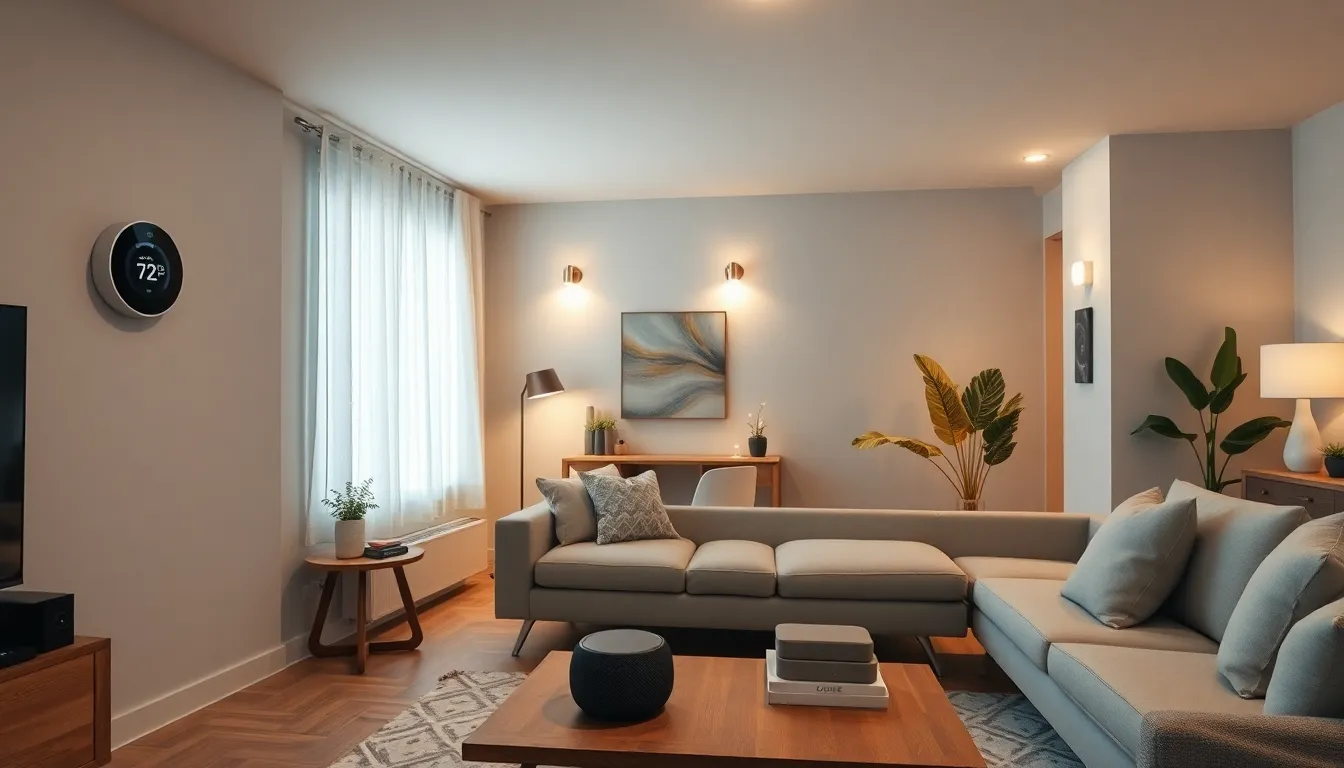Table of Contents
ToggleIn today’s fast-paced world, the concept of a connected home is transforming how people live, work, and interact with their surroundings. Smart devices seamlessly communicate with one another, creating an ecosystem that enhances convenience, security, and energy efficiency. From smart thermostats to voice-activated assistants, these innovations are making everyday tasks easier and more enjoyable.
As technology continues to evolve, homeowners are embracing the benefits of connectivity. The rise of the Internet of Things (IoT) has paved the way for a smarter lifestyle, allowing users to control their home environment from anywhere. This article explores the key components of a connected home, the advantages it offers, and how it’s shaping the future of residential living.
What Is a Connected Home?
A connected home refers to a residence equipped with smart devices that communicate over the Internet. These devices create an integrated environment, allowing homeowners to manage various aspects of their homes remotely.
Overview of Connected Home Technology
Connected home technology encompasses smart devices such as appliances, lighting, thermostats, security systems, and entertainment systems. These devices utilize the Internet of Things (IoT) to interact with each other and can be controlled through smartphones or voice-activated assistants. Examples of connected home technology include:
- Smart thermostats: Manage heating and cooling based on user preferences.
- Smart lighting: Adjust brightness and color remotely for energy efficiency.
- Security cameras: Provide real-time monitoring and alerts for enhanced safety.
- Smart locks: Enable keyless entry through mobile devices.
- Voice assistants: Facilitate control over other devices via voice commands.
Benefits of a Connected Home
Connected homes offer numerous advantages, including:
- Increased convenience: Automating routine tasks saves time, allowing homeowners to focus on other activities.
- Enhanced security: Monitoring systems provide peace of mind through real-time alerts and remote access.
- Energy efficiency: Smart devices optimize energy consumption, leading to cost savings on utility bills.
- Remote control: Homeowners can manage devices from anywhere using their smartphones.
- Customization: Settings can be tailored to individual preferences, improving the overall living experience.
Connected homes revolutionize daily living by enhancing functionality and connectivity, promoting a more efficient and enjoyable lifestyle.
Key Components of a Connected Home

Connected homes incorporate various smart devices and systems that enhance user experience and improve efficiency. Key components include smart devices and home automation systems.
Smart Devices and Appliances
Smart devices and appliances streamline household tasks and provide enhanced control. Examples include:
- Smart Thermostats: These devices allow users to adjust heating and cooling remotely, optimizing energy usage.
- Smart Lighting: Users can set schedules, dim lights, and change colors from mobile devices, improving ambiance and energy efficiency.
- Smart Security Cameras: These cameras offer real-time video feeds and alerts, ensuring home security.
- Smart Locks: They allow remote locking and unlocking, providing an added layer of security for homeowners.
- Smart Speakers: Voice assistants in smart speakers enable hands-free control of connected devices, music playback, and information retrieval.
Home Automation Systems
Home automation systems integrate multiple smart devices for centralized control. Key features include:
- Centralized Management: Users can control various devices through a single app or interface, simplifying management.
- Automated Routines: Homeowners can set routines for devices, such as turning off lights or adjusting the thermostat at specific times.
- Remote Access: Users can manage their home systems from anywhere, providing peace of mind and convenience.
- Customized Alerts: Automation systems can offer customized notifications for security breaches, maintenance reminders, or energy usage reports.
- Energy Monitoring: These systems can track energy consumption, helping users identify and reduce unnecessary energy costs.
These components work together to create a seamless connected home environment, enhancing daily living and enabling greater efficiency.
Security and Privacy in a Connected Home
Connected homes present unique security and privacy challenges. As smart devices become integral to daily living, understanding these risks and implementing best practices for protection remains essential.
Risks and Concerns
Connected homes face various risks and concerns, including:
- Data Vulnerability: Smart devices can collect personal data, increasing exposure to breaches. Unsecured devices may transmit sensitive information over the Internet.
- Unauthorized Access: Weak passwords or outdated software can lead to unauthorized access, allowing intruders to manipulate devices or access personal information.
- Interconnected Systems: A compromised device can serve as a gateway for hackers to infiltrate the entire network. The interconnected nature of these systems heightens potential damage.
- Privacy Invasion: Devices with cameras and microphones may inadvertently capture private moments, leading to privacy invasions.
Best Practices for Security
Implementing best practices enhances security and privacy in connected homes. Consider these strategies:
- Use Strong Passwords: Employ complex, unique passwords for each device. Avoid easily guessed passwords and frequently change them.
- Regular Software Updates: Keep all devices updated with the latest firmware and security patches to address vulnerabilities.
- Secure Network: Utilize a strong Wi-Fi password and enable network encryption. Consider using a separate guest network for smart devices to isolate them from personal devices.
- Two-Factor Authentication: Enable two-factor authentication for accounts associated with smart devices. This adds an additional layer of security against unauthorized access.
- Monitor Device Activity: Regularly review device logs to identify unusual activity. This can alert users to potential security breaches early.
- Disable Unused Features: Turn off features like remote access or services that are not in use, reducing exposure to risks.
By acknowledging the risks and implementing sound security practices, homeowners can better protect their connected environments.
Future Trends in Connected Homes
Connected homes are evolving rapidly, driven by innovation and consumer demands. Emerging technologies and market predictions illustrate the future landscape of smart living environments.
Emerging Technologies
Emerging technologies enhance connected homes in several ways, including:
- Artificial Intelligence (AI): AI algorithms analyze user behavior to automate tasks and optimize energy use, significantly increasing efficiency.
- 5G Connectivity: 5G networks improve device communication speed and reliability, allowing multiple devices to function seamlessly without lag.
- Voice Recognition: Advanced voice recognition systems enhance user interaction with smart devices, making commands more intuitive and responsive.
- Home Robotics: Robotic devices, like vacuum cleaners and lawnmowers, gain intelligence and connectivity to integrate with other smart home systems for more efficient operation.
- Smart Materials: Innovations in smart materials, such as self-healing concrete and energy-generating windows, contribute to sustainable and resilient home infrastructure.
Predictions for the Connected Home Market
| Year | Market Value (USD billion) | Growth Rate (%) |
|---|---|---|
| 2023 | 120 | 15 |
| 2025 | 205 | 25 |
| 2030 | 400 | 30 |
- Increased Adoption: More households will adopt smart technologies, with nearly 70% of homes expected to be equipped with one or more smart devices by 2025.
- Focus on Interoperability: Device manufacturers will prioritize compatibility among different brands and platforms, leading to unified ecosystems that enhance user experience.
- Rising Demand for Security Solutions: As connected devices proliferate, there will be a growing need for robust security solutions to safeguard against breaches.
- Sustainable Solutions: Consumers will increasingly seek eco-friendly technologies, driving innovation in energy-efficient devices and sustainable practices within connected homes.
- Integration with Smart Cities: As connected homes become part of larger smart city initiatives, homeowners will benefit from improved services, such as traffic management and waste reduction systems.
Connected homes are reshaping the way people live by integrating technology into everyday life. With smart devices working in harmony homeowners enjoy unprecedented convenience and control. The potential for enhanced security and energy efficiency makes connected living appealing to many.
As technology continues to advance the future of connected homes looks promising. Innovations in AI and 5G connectivity will likely further enhance user experiences while addressing security and privacy concerns. Homeowners must remain vigilant in protecting their digital environments to fully benefit from these advancements.
Embracing a connected home not only simplifies daily tasks but also paves the way for a more sustainable and efficient lifestyle. The journey toward a smarter home is just beginning and homeowners are poised to reap the rewards.


